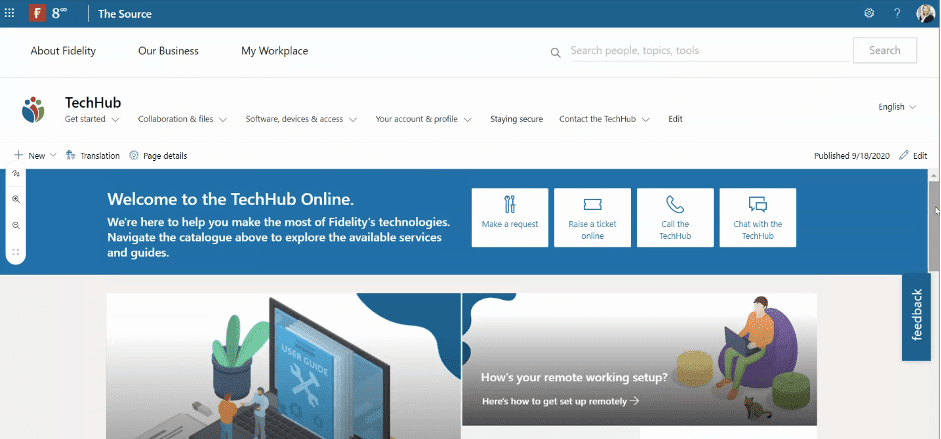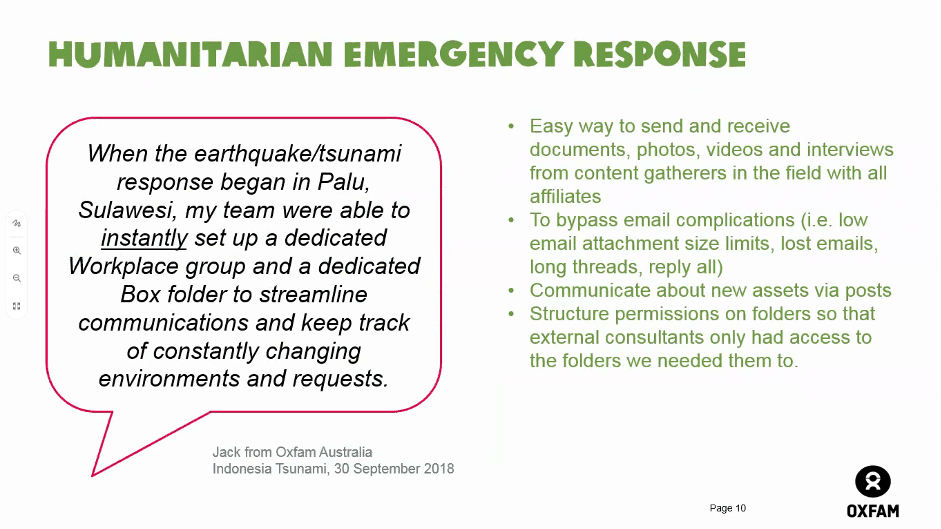Tech hubs, taxonomies and chatbots: four more takeaways from DWG24
During 2020 many events have pivoted to being virtual. While most of us miss in-person conferences and workshops to some extent, digital conferences and festivals have helped to bring the global digital workplace and intranet community together, to share knowledge and continue to learn.
In many respects, DWG24 was ahead of its time; DWG24 is a global 24-hour digital festival that celebrates the digital world of work though 24 hours of continual programming, featuring live tours of leading digital workplaces and interviews with experts. DWG held the first one in 2008, and the latest event took place from 30 September to 1 October 2020.
There were many valuable moments over the 24 hours. I recently wrote about four takeaways that stood out for me – here are four more valuable insights from DWG24 that I found particularly interesting. If you missed the live show, you can listen to the recordings via the DWG24 2020 Video Library.
1. Chatbots can help support frontline staff at scale
Chatbots and conversational interfaces have become increasingly common, in both the consumer world but also across the digital workplace. These are generally used for helping employees to carry out simple transactions and tasks, find pieces of information, or get answers to frequently asked questions – relieving the pressure on busy HR and IT support desks. As bots get more sophisticated and digital workplace teams acquire more experience in rolling them out, they are delivering increasing value and gaining acceptance among users.
During DWG24 we saw a great example of a chatbot making a difference. M. Video Eldorado Group is one of Russia’s largest high street retailers, selling consumer technology goods across more than 1,000 stores, with 31,000 employees. The company and its employees have experienced significant levels of change over the last two years, due to it being formed from a merger of two competitors in 2018, as well as the challenges of the pandemic during 2020.
To help bring the two separate brands together into one company culture, standardize processes and manage the change, the group has invested heavily in a digital workplace environment that all employees can access through their mobile phones. This has numerous features to help employees in their working day, support the culture and increase communications; one of these is a chatbot called EMily.
EMily answers commonly asked questions, helps employees find other people, and even tells jokes. What makes a chatbot work perfectly for a retail company like M. Video Eldorado Group is that it is well suited to interaction on a smartphone, which is how most employees working in retail outlets access digital channels and services both inside and outside work; it can also deliver answers in a tone of voice that suits a more relaxed company culture. When you need to support a workforce of 31,000, a tool like a chatbot can prove invaluable.

Above: EMily, M.Video Eldorado Group’s chatbot in action
2. Successful digital workplace environments support employee self-service
Successful intranets and digital workplace environments help employees to get things done, usually through a self-service approach, providing instructional content and the ability to perform simple transactions. In this regard, the intranet can save employees time because they can find what they need easily, they don’t have to visit multiple applications and they can access content they trust. This also relieves pressure on busy support teams within IT and HR functions.
Designing intranets that successfully support employee self-service is not always easy and, during DWG24, we were lucky to see a great example of an intranet that does just this. Fidelity International is a global investment and retirement savings business, with 9,000 employees primarily based in Europe and Asia-Pacific. Employees have a complex range of needs and use a variety of applications, so the digital workplace environment they access is very important.
At Fidelity International, the digital workplace team is striving to build a digital workplace experience that is a “trusted, seamless and centralized digital communications platform for all our employees worldwide”. The organization is on a Microsoft 365 journey and has launched Yammer, Microsoft Teams and a new intranet environment which leans in on SharePoint modern sites.
During DWG24, we got to see the company’s “TechHub Online”, a site that acts as a starting point for employees to find IT resources and interact with the IT help desk to sort out any issues. Displayed prominently are four calls to action where employees can make a request, log a ticket, call the TechHub team or live chat with a member of staff. A comprehensive and well thought-through mega menu also leads employees to topic-based self-serve resources themed around common needs.
During the pandemic, employees have increased their use of technology and IT help-desk teams have worked incredibly hard to support staff. It was good to hear that, at Fidelity International, the TechHub has played an active role both in supporting employees but also in relieving some of the pressure on the IT support team during an incredibly busy time.

Above: Fidelity International’s TechHub Online supports self-service for employees
3. Flexibility and speed in the digital workplace matter to support critical operations
Effective digital workplace platforms that facilitate robust collaboration and communication are essential for organizations to deliver their core operations and day-to-day work. This has never been truer than in 2020, when we have seen digital workplace tools do the heavy-lifting to support business continuity. Some organizations also need a highly flexible and agile digital workplace to be able to respond quickly to need; this is very important when part of your core mission is to save people’s lives.
During DWG24, we heard how Oxfam International has organized its digital workplace to empower groups to set up spaces that support its critical work around the world in ending hunger and responding to emergencies. Oxfam International is a confederation of global NGOs, comprising 20 affiliate organizations working across more than 60 countries. Oxfam has a robust digital workplace with a range of core platforms, tools and underlying governance to support its needs, including Box to share documents and Workplace from Facebook for communication and collaboration.
One powerful situation we heard about was how emergency teams are able to set up spaces using Workplace and Box, which can then be used to collaborate both across Oxfam and with external parties, enabling the sharing of communications and assets. This not only helps with urgent operations but also supports important fundraising efforts. In the quote in the slide below, the important word is “instantly” – the digital workplace team have been able to remove all the barriers sometimes associated with site provisioning and approval processes to empower the team to set up what they need themselves. While sometimes a more controlled provisioning process is important in order to manage a platform and avoid issues like duplicate sites, Oxfam’s example is a good reminder that speed and flexibility in the digital workplace can be very important.

Above: Oxfam International’s digital workplace supports emergency response efforts
4. It takes specialist work in the background to drive strong findability
Digital workplace environments don’t just magically happen through the power of technology; they actually need a whole range of governance approaches, expert and specialist input, and change management as well as ongoing day-to-day management behind the scenes, to make them work properly. Sometimes, users and stakeholders don’t always realize the hard work involved in the background, with a classic example of this being search and findability. There is still an assumption that if you plug in a search tool it’s going to work instantly in various sophisticated ways.
During DWG24, there was a fascinating session from Ubisoft, a leading gaming producer that has a highly sophisticated digital workplace. At Ubisoft, there is a strong commitment to findability, enabling its employees to view all content across different formats, platforms and repositories on a number of key topics based on common metadata. This not only allows users to search for information and also browse by relevant topic, but also delivers recommendations for useful content based on user profiles and behaviours. Many organizations struggle with findability and Ubisoft is more mature in this respect than in many other sectors.
Something as advanced as this can only work through a common taxonomy and term set; to make this happen takes a considerable amount of specialist ontology management work. For example, we were shown some of the software that is used to manage the taxonomy which details all the relationships across the term set.
What is particularly impressive is that with a detailed taxonomy operational, the team have been able to build upon it and have started to introduce auto-tagging of content based on machine learning, with increasing degrees of precision. Ultimately, this again helps to save people time and supports findability across a complex digital workplace ecosystem.

Above: Ubisoft uses taxonomy management software to support better findability
Take the next step…
Categorised in: Collaboration, Internal communications, Mobile sites & apps, Search & findability
